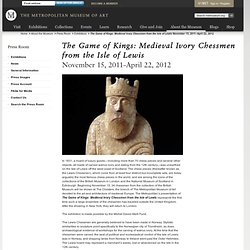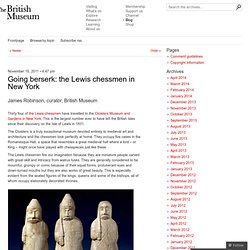

Highlight image. <i><b>The Game of Kings: Medieval Ivory Chessmen from the Isle of Lewis</i></b><br>November 15, 2011–April 22, 2012. In 1831, a hoard of luxury goods—including more than 70 chess pieces and several other objects, all made of carved walrus ivory and dating from the 12th century—was unearthed on the Isle of Lewis off the west coast of Scotland.

The chess pieces (thereafter known as the Lewis Chessmen), which come from at least four distinct but incomplete sets, are today arguably the most famous chess pieces in the world, and are among the icons of the collections of the British Museum in London and the National Museum of Scotland in Edinburgh. A History of the World - Object : Lewis Chessmen. The Lewis Chessmen. The British Museum exists to tell the story of cultural achievement throughout the world, from the dawn of human history over two million years ago until the present day.

The Museum is a unique resource for the world: the breadth and depth of its collection allows the public to re-examine cultural identities and explore the complex network of interconnected world cultures. Within the context of this unparalleled collection, the Lewis Chessmen are an important symbol of European civilisation. Each year millions of visitors, free of charge, admire the chessmen at the British Museum and they are frequently loaned for display in museums across the country and across the globe. What are they? The Lewis Chessmen form a remarkable group of iconic objects within the world collection of the British Museum. Of the 93 pieces known to us today, 11 pieces are in Edinburgh at the National Museum of Scotland, and 82 are in the British Museum. What is their history? Where are they on display? Lews Castle. Going berserk: the Lewis chessmen in New York. James Robinson, curator, British Museum Thirty four of the Lewis chessmen have travelled to the Cloisters Museum and Gardens in New York.

This is the largest number ever to have left the British Isles since their discovery on the Isle of Lewis in 1831. The Cloisters is a truly exceptional museum devoted entirely to medieval art and architecture and the chessmen look perfectly at home. They occupy five cases in the Romanesque Hall, a space that resembles a great medieval hall where a lord – or King – might once have played with chesspieces just like these. The Lewis chessmen fire our imagination because they are miniature people carved with great skill and intricacy from walrus tusks. Hebrides-cbc82_1296602756.jpg (440×375) The Lewis Chessmen. Probably made in Scandinavia, thought to be Norway, about AD 1150-1200 | Found on the Isle of Lewis, Outer Hebrides, Scotland The chess pieces consist of elaborately worked walrus ivory and whales' teeth in the forms of seated kings and queens, mitred bishops, knights on their mounts, standing warders and pawns in the shape of obelisks.
They were found in the vicinity of Uig on the Isle of Lewis in mysterious circumstances. Various stories have evolved to explain why they were concealed there, and how they were discovered. All that is certain is that they were found some time before 11 April 1831, when they were exhibited in Edinburgh at the Society of Antiquaries for Scotland. The precise findspot seems to have been a sand dune where they may have been placed in a small, drystone chamber.
Who owned the chess pieces? By the end of the eleventh century, chess was a very popular game among the aristocracy throughout Europe.